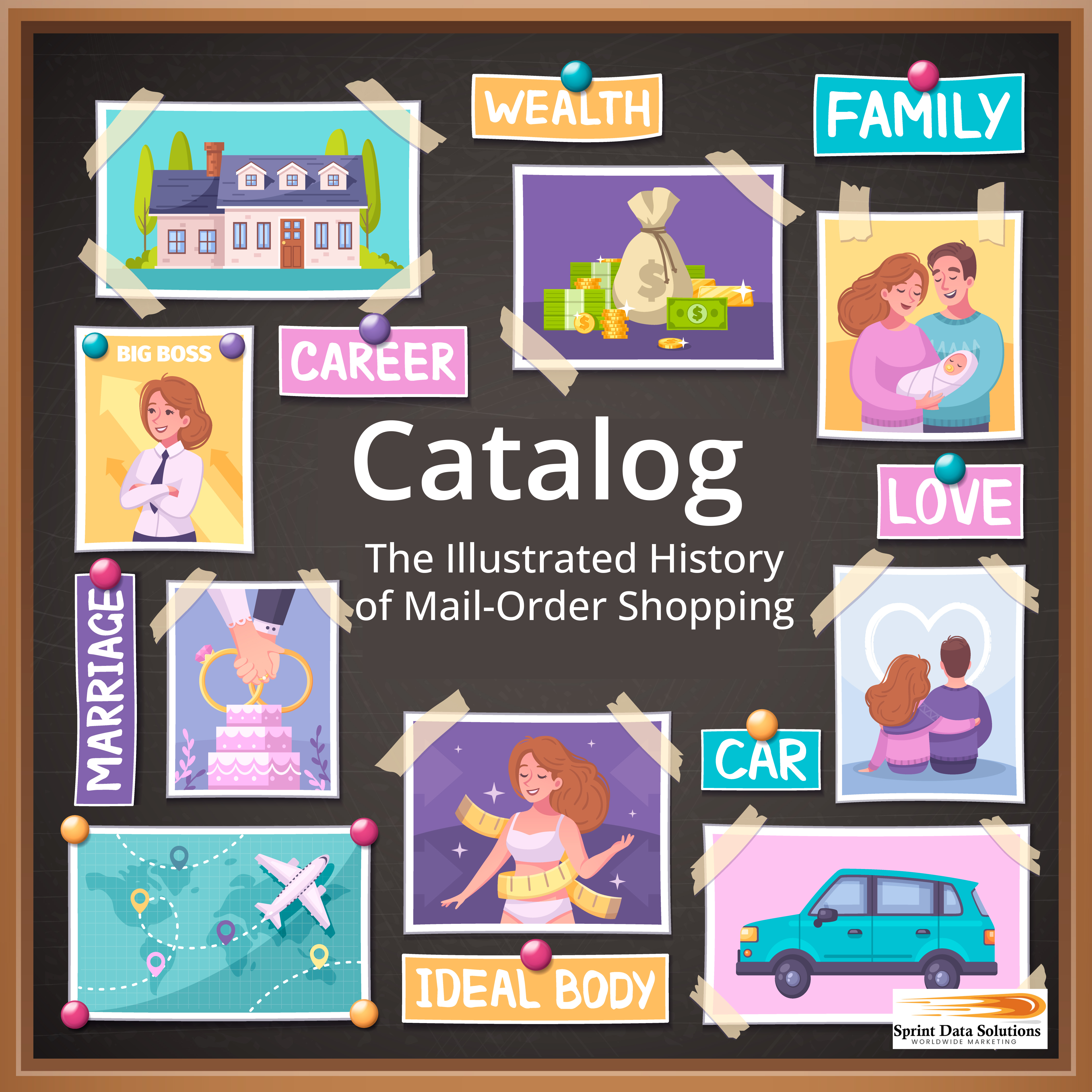Catalog & Magazine Mailing List
The 21st century has ushered in significant transformations across various aspects of life, especially in how we shop. What was once a conventional activity—physically going to stores, markets, or shopping malls to browse and purchase goods—has now evolved into a largely digital experience. Online shopping, powered by e-commerce platforms and websites, has become the dominant force in retail, providing consumers with the convenience of purchasing anything from the comfort of their homes. However, despite the growing prevalence of digital shopping, the catalog—a time-honored marketing tool—has remained an enduring part of the retail landscape, adapting to the digital age.
While catalogs originated in a pre-digital era when print media ruled, they have adapted to modern times, integrating with digital technology. Today, digital catalogs allow customers to browse and shop online, just like traditional printed versions, but with the added benefit of interactive features such as direct links to product pages, real-time inventory tracking, and instant purchasing options. Catalogs serve as more than just a listing of products—they evoke a sense of nostalgia and provide a tactile, visual experience that complements online shopping. Even in the digital era, the catalog remains a valuable tool for businesses, as it engages customers in a way that other marketing methods, such as search engine optimization or paid digital ads, often can’t replicate.
Beyond catalogs, traditional marketing channels such as magazines, flyers, and direct mail continue to play an essential role in the modern marketing ecosystem. These media have successfully adapted to the digital age by embracing digital formats, but they still hold immense value for certain audiences, particularly those who appreciate the tactile, tangible experience of print. For businesses that target the catalog-reading or magazine-consuming demographic, Sprint Data Solutions Worldwide Marketing offers specialized solutions, leveraging deep insights into consumer behaviors to help brands connect with potential customers through both traditional and modern marketing channels. Whether you’re seeking to build a robust customer base through direct mail catalogs or digital marketing campaigns, Sprint Data Solutions Worldwide Marketing offers the expertise and data-driven strategies needed to ensure your marketing reaches the right audience.
The Sprint Data Solutions Worldwide Marketing Story
Sprint Data Solutions Worldwide Marketing is a 100% American-owned business with a unique foundation. Founded by a disabled veteran, the company was born out of a vision to pivot from a career in defense to one centered on fostering economic growth. After fulfilling the obligations of military service, the founder chose to channel their dedication into helping U.S. businesses expand and thrive. This vision led to the establishment of Sprint Data Solutions Worldwide Marketing, which began operations in Las Vegas, Nevada. Over the years, the company has experienced consistent growth, built upon a core commitment to service quality and innovative marketing strategies. Today, Sprint Data Solutions is proud to employ a team with over 50 years of combined experience in marketing, data analytics, and sales. The company’s expansion into both digital and traditional marketing services has positioned it as a trusted partner for businesses seeking to enhance their reach and customer engagement. With a focus on delivering precise, tailored solutions, Sprint Data Solutions Worldwide Marketing continues to support the success of companies across diverse industries.
At the outset of Sprint Data Solutions Worldwide Marketing’s operations, the marketing landscape was dominated by traditional, analog platforms such as print media, television commercials, and direct mail campaigns. Recognizing the potential of direct mail, the company chose to specialize in this area, carving out a niche in the print marketing industry. Over the decades, direct mail proved to be an enduringly effective strategy for reaching targeted audiences, and it remains a cornerstone of Sprint Data Solutions’ service offerings to this day. However, as the digital age dawned and the internet revolutionized marketing methods, the company saw an opportunity to expand its services to keep pace with changing technologies and consumer behaviors.
Starting from a small, local base in Las Vegas, Nevada, Sprint Data Solutions Worldwide Marketing grew rapidly, extending its reach across the entire state and eventually to every corner of the continental United States. This expansion laid the groundwork for the company’s broader vision, which soon saw it branching out to serve Alaska and Hawaii, ensuring a comprehensive nationwide presence. By continually adapting to the evolving market demands, the company further expanded its services to include North American markets such as Canada and Mexico, positioning itself as a key player in the region. Recognizing the global potential, Sprint Data Solutions Worldwide Marketing then expanded its operations internationally, offering full access to European Union markets like France, becoming a truly global marketing provider.
Despite its rapid growth, Sprint Data Solutions remained committed to direct mail as the foundation of its success. Yet, the company also recognized that the future of marketing lay in digital innovations. As technology advanced and the need for online presence surged, Sprint Data Solutions embraced digital marketing, developing a robust suite of services that complemented its traditional offerings. This seamless integration of digital marketing strategies alongside direct mail allowed the company to serve a more dynamic and diverse clientele, from small businesses seeking local engagement to multinational corporations with global outreach. Through continuous innovation and strategic service expansion, Sprint Data Solutions Worldwide Marketing has solidified its position as a comprehensive marketing partner for businesses across the globe.

The Catalog & Magazine Advantage
Catalogs and magazines have long been cherished for their tangible, nostalgic qualities, and despite the rise of digital marketing, they continue to hold significant value in today’s world. Physical catalogs, with their curated content and high-quality visuals, offer a sensory experience that digital platforms often struggle to replicate. The appeal of holding a catalog and flipping through its pages, perhaps while relaxing at home, is a form of engagement that still resonates with many. In an era dominated by instant online transactions, the deliberate pace of browsing through a catalog provides a sense of thoughtfulness and even discovery. Magazines, too, have retained their charm. In fact, when executed well, magazines often offer a higher standard of editorial design and presentation compared to fast-paced, less polished websites. The artistry of a carefully designed magazine—combining compelling narratives, stunning photography, and expert curation—can create a deeper connection with the reader than digital content that often sacrifices quality for speed. Furthermore, one of the key advantages of magazines and catalogs is their independence from technology. Readers can enjoy them without relying on an internet connection or the need to scroll through endless search results. Catalogs and magazines provide an interruption-free, tactile media experience that digital advertisements can’t always offer. They stand out, bypassing the noise of crowded inboxes or social media feeds, offering a personalized and tangible connection with potential customers. When the moment arrives to make a purchase, modern catalogs and magazines conveniently integrate with digital tools—such as QR codes, phone numbers, or website URLs—ensuring customers can transition seamlessly to online ordering or personal assistance, preserving the physical appeal while adapting to the convenience of today’s technology. This can be useful for businesses such as:
Home Cooking Magazines
The pandemic significantly altered dining habits, with many people reducing the frequency of eating out and shifting toward cooking at home. This change, which began during lockdowns, has persisted even as the pandemic subsides. For many, home-cooked meals offer a more budget-friendly option compared to dining at restaurants, especially when considering the rising costs of eating out. Additionally, cooking at home allows for greater control over ingredients, portion sizes, and dietary preferences, which can lead to healthier meal choices. Cooking magazines, with their carefully curated recipes and detailed instructions, have become an essential resource for home chefs. Unlike digital devices such as phones or tablets, which can be prone to distractions and may not be as practical in the kitchen, magazines provide a tactile and convenient alternative. With their easy-to-follow layouts and ability to withstand spills and stains, cooking magazines remain a trusted and reliable tool for anyone looking to elevate their culinary skills while keeping their budget in check.
Fine Wines
Wine is not just a drink; it is a passion, a hobby, and for some, even a lucrative investment. The world of wine is rich with tradition, culture, and history, which makes it a sophisticated and multifaceted interest. For wine enthusiasts, magazines and catalogs dedicated to wine remain highly valuable resources, offering not only a curated selection of wines but also in-depth knowledge about the wine culture itself. These publications serve as a bridge between consumers and the expansive world of wine, featuring everything from accessible, everyday table wines to prestigious, award-winning selections. Additionally, niche categories like rare ice wines, sought after for special occasions, appeal to collectors and connoisseurs alike.
Marketing wine requires a nuanced approach, as it spans a wide range of consumer demographics and economic levels. For the everyday wine drinker, the emphasis may be on affordability and taste, with recommendations for accessible wines that fit various occasions. However, for those who seek the finer wines in life, such as limited edition releases or high-end vintage collections, the focus shifts to exclusivity and craftsmanship. Wine magazines and catalogs cater to these diverse interests by offering educational content that dives deep into the wine’s history, production techniques, and tasting notes. They keep wine lovers informed about current trends, including new varietals, sustainability practices in viticulture, and emerging wine regions. Ultimately, successful wine marketing blends education with passion, offering a complete experience that celebrates the artistry of winemaking while appealing to both novice drinkers and seasoned collectors.

Cigars
Much like wine, cigars are often seen as a symbol of luxury and sophistication, appealing to those who appreciate fine, curated experiences. They have a rich history that spans centuries, with deep cultural significance in many regions. While cigars may not have the everyday consumption frequency of cigarettes, they occupy a special place in the lives of connoisseurs, offering moments of relaxation and indulgence. The appreciation for cigars, much like wine, is an acquired taste—one that is developed through experience and exposure to different types, flavors, and blends. The ritualistic aspects of cigar smoking, such as choosing the right cigar, cutting it with precision, and lighting it carefully, add to the appeal for many enthusiasts. As cigars are consumable, they eventually need to be replenished, encouraging repeat purchases and the exploration of new varieties. This presents a unique marketing opportunity, as consumers often look for new, premium options to elevate their experience. With proper branding, presentation, and educational content, businesses can highlight the unique characteristics of specific cigars, from their origin to the nuances of their taste, and create an engaging, informative experience for the right audience. Targeting the right demographic, such as affluent individuals or those with a penchant for luxury leisure, can yield significant results, allowing businesses to create a deep connection with consumers and drive brand loyalty.
Household Goods
Homes rely on a wide variety of products to function efficiently and maintain comfort. From everyday necessities like dish soap and cleaning supplies to more specialized items such as air fresheners, water filters, or lawn care products, each room of the house has its own set of requirements. Seasonal needs add another layer, such as salt for the sidewalks in winter or insect repellents in the summer. Catalogs are an invaluable resource, offering comprehensive listings of the various products and services required to maintain a home, often broken down by category and use. On the other hand, magazines provide helpful insights, offering expert advice on selecting the best products, sharing time-saving techniques, and even offering tips on improving efficiency and functionality. These publications not only showcase products but also guide homeowners on how to use them effectively, ensuring homes stay in optimal condition year-round.
Children’s Products
The market for children’s products is vast and continuously evolving, encompassing a wide range of categories, including educational resources, health and nutrition products, entertainment options, and developmental tools. Within this expansive market, catalogs play a crucial role by showcasing products that cater to every aspect of a child’s needs, from early learning aids to toys and clothing. However, children’s magazines stand out as an effective tool for engaging parents. These publications offer a unique platform to present new ideas, trends, and innovations in the parenting space. Parents are particularly open to discovering products and services that enhance their child-rearing journey, whether it’s improving educational outcomes, supporting their child’s well-being, or providing enriching experiences. By focusing on relevant, practical, and well-researched content, children’s magazines can foster trust and inspire purchasing decisions, making them a powerful medium for connecting with parents and caregivers.
CBD Oil & CBD Creams
As the legal landscape surrounding cannabis continues to evolve across the United States, CBD oil has rapidly gained recognition as a versatile and effective remedy for a variety of health issues, including stress, chronic pain, anxiety, and digestive disorders. Derived from cannabis, CBD is distinct from THC, the psychoactive component of the plant, and does not produce the intoxicating effects typically associated with marijuana use. This makes CBD oil suitable for a wide range of consumers, from seniors seeking relief from joint pain and inflammation to athletes utilizing topical CBD products for muscle recovery. The growing acceptance of CBD products among different demographics highlights the importance of tailored marketing strategies, especially through magazines, catalogs, and other content-rich formats that educate and inform consumers about the benefits of CBD. For seniors, CBD oil often serves as a natural, non-habit-forming alternative to traditional pain management methods, offering relief without the side effects of prescription medications. Meanwhile, athletes and active individuals are increasingly turning to CBD-based balms and creams to ease muscle soreness and promote faster recovery after intense workouts or physical activity. As such, understanding the unique needs and preferences of these different consumer groups is essential when crafting marketing messages that resonate with each audience.
Sports Magazines & Products
Sports have long had specialized magazines dedicated to providing in-depth coverage of various games, athletes, and events, and this demand for detailed information continues to thrive. From widely popular sports like basketball to more niche interests such as bobsledding, enthusiasts are always seeking fresh insights, updates, and expert commentary. These publications cater not only to the avid fans who crave detailed game analyses but also to those looking to understand the intricacies of the sports they follow, whether through historical context, athlete profiles, or strategic breakdowns.
Additionally, the market for sporting products remains robust, with a continuous need for comprehensive catalogs and magazines that effectively showcase the latest gear, equipment, and apparel relevant to specific sports. These publications serve as essential tools for consumers, guiding them through the variety of products available while highlighting the innovations and trends shaping the sporting world. Whether it’s a catalog for soccer enthusiasts featuring new cleats, a magazine detailing the latest advancements in cycling technology, or a guide to winter sports equipment, there’s a clear and ongoing demand for these specialized resources. The key to success in this market lies in matching the right products with the appropriate sports, ensuring that the content resonates with the intended audience—whether that be competitive athletes, recreational players, or fans simply looking to stay connected to their sport of choice.
Seeds & Plants
Gardening has long been a beloved activity for many Americans, deeply embedded in the cultural fabric of home life. However, in recent years, gardening has gained even more momentum due to the growing emphasis on sustainability, eco-friendliness, and the increasing interest in self-sufficiency. With concerns about food security and the environmental impact of large-scale agriculture, more people are turning to their own backyards as a way to grow fresh, organic produce. This shift is not only driven by a desire to reduce carbon footprints, but also by the significant savings that come from growing your own food. Whether it’s herbs on a windowsill, vegetables in raised garden beds, or flowers brightening up the front yard, the demand for seeds and plants has surged. A wide array of gardening products and services can be tailored to meet the needs of everyone, from beginners starting their first garden with easy-to-grow plants to seasoned gardeners seeking more advanced seeds, tools, and techniques to enhance their hobby. This renewed interest presents numerous opportunities for businesses to provide a variety of solutions, including specialized seeds, eco-friendly fertilizers, gardening tools, and even online tutorials for advanced gardening practices.
Collectibles
Collectibles as a consumer demographic is vast and diverse, with specific subcultures exhibiting very distinct interests and purchasing behaviors. For instance, stamp collectors, vinyl enthusiasts, and retro gamers each represent highly passionate yet very different groups. Stamp collectors are generally driven by historical value, rarity, and condition, often seeking older, limited-edition items from particular countries or time periods. Vinyl enthusiasts, on the other hand, tend to be motivated by both nostalgia and the tactile experience of analog music, showing interest in both contemporary pressings and vintage records, often valuing the album artwork and the auditory quality of vinyl over digital formats. Retro gamers, in contrast, focus on specific hardware, software, and accessories from past decades, often searching for rare or mint-condition games and consoles that may evoke memories of their childhood or simply serve as nostalgic investments.
Given the highly segmented nature of these hobbies, it’s crucial for catalogs, magazines, and marketing materials to be hyper-targeted and niche-specific. A general collectible magazine or catalog is unlikely to generate meaningful engagement from all these groups, as each collector’s preferences and motivations are distinct. A publication focused on rare stamps will not appeal to a retro gamer or a vinyl collector, while a magazine dedicated to gaming hardware will fail to resonate with those interested in the nuances of vinyl records or philately. However, when marketing materials are tailored to the specific interests of each group—whether it’s a vinyl-focused magazine or a collector’s guide to retro gaming gear—the response is often highly engaged. Consumers within these niche markets respond strongly to specialized content that aligns with their personal collecting passion, leading to greater engagement, loyalty, and sales. This level of specificity in marketing is essential for connecting with collectors on a deeper level and driving successful campaigns.

Clothing & Fashion
Clothing has consistently remained a cornerstone of consumer purchases and continues to be a major category in both catalog and online sales. The appeal of clothing spans across various demographics, with different types of apparel resonating with diverse consumer needs and preferences. While fashion remains a primary driver for many, certain segments, particularly professional and workwear clothing, place greater emphasis on functionality, durability, and protective features. These items are often purchased not just for their aesthetic value, but for their practicality, such as providing comfort in demanding environments or meeting specific occupational requirements. For these customers, purchasing decisions may lean more toward value and long-term investment rather than trendiness.
In the world of catalog and magazine sales, the importance of visual presentation cannot be overstated. High-quality photography is essential in making clothing stand out, as it helps convey the product’s true value, texture, and fit. Capturing clothing in dynamic, engaging ways through imagery allows customers to visualize how it will look and feel in real life, making the purchase feel more tangible. Furthermore, combining compelling imagery with informative content about the clothing—such as detailing the materials, design features, or benefits for specific uses—can drive consumer interest and foster a deeper connection with the product. Whether it’s casual wear, formal attire, or specialized workwear, catalogs that invest in showcasing clothing with both aesthetic appeal and functional benefits can capture a broader audience and generate higher engagement and sales.
Home Improvement
While collaborating with professionals can yield high-quality home improvement and renovation results, it often comes with a significant price tag, which makes “Do It Yourself” (DIY) home improvement a popular and cost-effective alternative for many homeowners. This preference for DIY projects remains strong, as individuals often feel a sense of accomplishment from taking on tasks themselves, from simple repairs to more ambitious renovations. However, businesses that specialize in home improvement products or services can still tap into this growing market, provided they effectively reach the right consumer audience. Whether it’s repairing a leaky faucet, updating outdated bathroom fixtures, or undertaking a complete kitchen overhaul, homeowners are constantly seeking ways to enhance and personalize their living spaces. This makes home improvement a thriving and diverse industry, with niches such as energy-efficient upgrades, outdoor living expansions, custom cabinetry, and foundation repairs. With such a broad spectrum of opportunities, the potential for targeted marketing efforts is vast. Offering the right products, services, or guidance to the DIY community, as well as to those seeking professional help, can result in substantial business growth. Whether it’s through expert advice, high-quality materials, or time-saving tools, businesses can strategically position themselves as the go-to resource for homeowners eager to improve and elevate their properties.
Precision Marketing
Success in traditional print marketing, whether through catalogs, magazines, or direct mail, hinges on realistic expectations for response rates. While it’s tempting to envision a perfect outcome, a 100% response rate is an unrealistic goal. However, businesses can significantly increase their likelihood of engagement by following strategic steps that target the right audience with the right message. The key to achieving a strong response rate is not casting a wide net, but rather focusing on precision and relevance in audience selection.
One of the biggest mistakes a business can make is adopting a broad, one-size-fits-all approach, especially when using purchased mailing lists. For instance, sending catalogs to an indiscriminate list of hundreds of thousands of addresses may seem like a surefire way to generate sales. However, this strategy ignores the fundamental truth that not every recipient will be a potential customer. If a business sells products designed for young children, sending catalogs to an audience of single college students or childless adults will result in an abysmally low response rate. The lack of relevance means these recipients simply have no interest in what’s being offered, leading to wasted resources and poor conversion.
In contrast, honing in on a highly targeted audience dramatically increases the chances of success. For example, a business that specializes in children’s toys for ages 2-10 can vastly improve response rates by carefully selecting addresses from a database of parents with children in this age group. Even if the list contains only a few thousand addresses, the likelihood of engagement skyrockets compared to a larger, less focused list. This strategy emphasizes quality over quantity, focusing marketing efforts on a group of individuals whose needs align with the product, ensuring that the marketing message resonates more effectively.
This targeted, data-driven approach may seem counterintuitive, especially when the audience size is smaller. However, the benefits of precision far outweigh the risks of casting a broad, generic net. By focusing on individuals who are already more likely to be interested in a product, businesses not only maximize their response rate but also improve the efficiency of their marketing spend. Ultimately, tailored marketing efforts that cater to specific interests and needs result in greater engagement, increased sales, and higher customer loyalty.
We’re Here To Help
Over the years, Sprint Data Solutions Worldwide Marketing has developed and maintained an extensive collection of databases, tailored to meet the specific needs of both consumer and B2B markets. A key focus has been ensuring that these databases remain accurate and relevant, with a proactive approach to preventing inefficiencies like sending marketing materials to outdated contacts, such as deceased individuals or people who no longer engage with a particular market niche. The company places great emphasis on the continuous updating and verification of its data, recognizing that outdated information can undermine the effectiveness of a marketing campaign. As communication channels have evolved, so too has Sprint Data Solutions Worldwide Marketing’s approach. Gone are the days when traditional physical addresses were the only means of reaching customers. Today, the company is equipped to support an array of diverse contact points, ranging from telephone numbers for direct voice calls to email addresses for targeted digital outreach and mobile phone numbers for personalized text or SMS campaigns. This multi-channel approach allows businesses to engage with their audiences more effectively across a variety of platforms, ensuring maximum reach and relevance in an increasingly digital world.
Find The Right List For You
At Sprint Data Solutions Worldwide Marketing, we offer comprehensive and customizable mailing lists tailored to various consumer and business needs, including catalog and magazine buyers, mail-order shoppers, and a wide array of other specialized markets. Our databases are meticulously categorized to ensure precise targeting for both B2C and B2B marketing campaigns. With these extensive lists, businesses can hone in on specific consumer behaviors and purchase patterns that align with their offerings, ensuring a higher return on investment. Our geographic targeting capabilities are highly flexible, allowing businesses to scale their outreach from a national scope down to a highly localized focus. Whether you’re targeting a broader market across the United States, narrowing your focus to specific regions like New England, or even zeroing in on individual states, cities, or neighborhoods, Sprint Data Solutions Worldwide Marketing can provide the exact coverage your campaign requires.
Additionally, we offer an expansive selection of demographic data, ensuring that every profile reflects the latest consumer trends and preferences. This data is carefully compiled, regularly updated, and consistently evaluated to guarantee its accuracy and relevance. The demographic characteristics covered by our databases are far-reaching, encompassing key factors such as age, gender, income level, education, occupation, interests, and lifestyle choices, among many others. These data points allow businesses to reach the most relevant and responsive audiences, whether they are targeting niche markets or broad consumer segments. Whether you’re looking for a precise list of catalog buyers with specific spending habits or a general mailing list tailored to a broader audience, Sprint Data Solutions Worldwide Marketing ensures that your data is always current and actionable, maximizing the impact of your marketing efforts.
- Age
- Ethnicity
- Debt
- Age of Children
- Renter
- Homeowner
- Income
- Marital Status
- Mortgage Data
- Geography
- Veteran Status
- Big & Tall Mail Order Buyers
At Sprint Data Solutions Worldwide Marketing, we understand the importance of reaching the right audience with your catalogs and magazines. Whether your campaign is broad or hyper-targeted, our extensive databases allow us to customize your direct mail lists based on a range of demographic, geographic, and psychographic factors. By using advanced data analytics and cutting-edge segmentation techniques, we can ensure your catalogs and magazines are delivered directly into the hands of individuals most likely to engage with your content. Whether you’re targeting a specific interest group, a local community, or a global market, our comprehensive data-driven approach maximizes your marketing efforts and delivers measurable results. Trust Sprint Data Solutions to help you connect with responsive, high-quality customers who are ready to engage with your brand, driving both short-term success and long-term growth.






